Germanic coins
Germanic coins: The birth of Germanic coinage is one of the major results of contacts between the →Barbaricum and the Roman Empire. Germanic coins took form as an effect of imitation of Roman coins, a gradual adoption of the Roman technology and, as a last stage, of the weight standard prevailing within the Empire.
→Germanic tribes start manufacturing the first imitations presumably around AD 2nd/3rd century. These were imitations of 1st and 2nd-century denarii of which a great number entered the territory of the →Barbaricum during the 2nd half of the 2nd century as a result of political contacts. In the Roman Period and the early →Migration Period imitative denarii are observed across a large area of the →Barbaricum, in both the Western and the Eastern Germanic territory, especially in denarii hoards, and range from Westphalia, Gotland, through Poland (→Przeworsk culture, →Wielbark culture) to the Great Hungarian Plain, Moldova, Ukraine and southwestern Russia (Cherniakhiv/Sântana de Mureš culture). The great number of imitative coins with identical dies may surface a considerable distance apart, suggesting they were produced in a single centre. It was presumably located in the →Gothic environment in Ukraine (Cherniakhiv culture), this is suggested by a major concentration of imitative denarii recorded in this region although the operation of early mints in other areas also cannot be discounted, especially the territory settled by the →Przeworsk culture, identified with the →Vandals. In their iconography imitative denarii range from very faithful rendition of the original types to designs which hardly resemble the Roman prototype. In Ukraine some imitative denarii were made of soft alloy, cast in bronze moulds. Few of the imitative denarii were pierced or looped for suspension; this makes their purpose – especially as their number is much smaller than that of the original denarii – even harder to explain.
After the battle of Abritus in AD 251 we find across much of the territory of the →Barbaricum finds of Roman aurei, perforated from their obverse above the imperial portrait. These coins are interpreted as prestige objects, perhaps reserved for members of war bands (comitatus). Although the influx of original aurei continued until the end of the 3rd century, their number may have been too small to satisfy a growing demand and imitations started to be manufactured. One of the first imitative gold coins were struck in Ukraine from original Roman coin dies used for making bronze coins, robbed from a colonial mint in Alexandria Troas in Asia Minor by Goths during their raid of AD 262. This would explain why at first the weight of the gold imitations was significantly different from that of the Roman aureus. Nearly all the early Germanic imitations made of gold or gold-plated were pierced. At the end of the 3rd century fashions changed and perforations are gradually replaced by loops for suspension, attached above the head of the emperor. In many of these coins the image is greatly simplified or altered, although there is a certain observable iconographic consistency, especially when it comes to the symbols of power, including elements of the military equipment. The legend is alliterate, as a rule, without any semantic relationship, although a →runic inscription has been identified on one of these coins.
Starting from the late Constantine emperors the development of the Germanic coinage was in two directions. In Central and Northern Europe gold coins apparently continue to be used for prestige only. This is true of the gold imitations of Roman medallions of the 4th century, and →Scandinavian bracteats with runic inscriptions of the 5th and the 6th cc. On the other hand, at the end of the 4th and the beginning of the 5th century, parallel to the migrations of the →Germanic tribes west and southward, we observe a continuity of gold anonymous issues. Moreover, in the Middle Danube region, most likely at Sirmium (Sremska Mitrovica), silver coins (siliquae and their fractions) with a monogram of the Germanic king are issued, presumably by the →Gepids. Modelled on the →solidus, a local coinage may be seen to develop in the first Germanic kingdoms (→Ostrogoths, Suebi, →Visigoths and →Langobards) established during the 5th century and later over the ruins of the Western Roman Empire. These coins gradually take on the characteristics of currency. In the second half of the 5th and the first half of the 6th century some of these coins pass to the Baltic region within a wave of Roman solidi.
Germanic coinage of the first half of the 1st millennium will be studied within a three-year research project IMAGMA implemented 2016-2018 as part of the Beethoven programme by the National Science Centre Poland and Deutsche Forschungsgemeinschaft, see www.imagma.eu.
AB
Literature: V. V. Kropotkin, Varvarskie podrazhania zolotym monetam v vostochnoi Evrope, Slovenská Numizmatika 4, 1976, p. 11-35; Th. Öhnell, Skandinaviska immitationer av romerska medaljonger, Uppsala 1996; A. Bursche, Roman gold medallions in Barbaricum. Symbols of power and prestige of Germanic elite in Late Antiquity, (in:) B. Kluge, R. Weisser (eds.), XII. Internationaler Numismatischer Kongress Berlin 1997, Akten – Proceedings – Actes, vol. II, Berlin 2000, p. 758-771; K. Stribrny, Funktionsanalyse barbarisierter, barbarischer Denare mittels numismatischer und metallurgischer Methoden. Zur Erforschung der sarmatische-germanischen Kontakte im 3. Jahrhundert n. Chr., Studien zu Fundmünzen der Antike Bd. 18, Mainz am Rhein 2003; M. A. Meetlich, The Coinage of Ostrogothic Italy, London 2004; P. Grierson, M. Blackburn, Medieval European Coinage: 1, The Early Middle Ages (5th-10th centuries), Cambridge 2006; K. V. Myzgin, “Varvarskie” podrazhania rimskim monetam na territorii Cherniachovskoi kul’tury, Drevnosti 9, 2009, p. 90-106; A. Stahl, The transformation of the West, (in:) W. E. Metcalf (ed.), The Oxford Handbook of Greek and Roman Coinage, Oxford 2012, p. 642-646; A. Bursche, The battle of Abrittus, the Imperial treasury and aurei in Barbaricum, Numismatic Chronicle 173, 2013, p. 151-170; H. W. Horsnæs, Networking in north-eastern Barbaricum: a study of gold imitations of Roman coins, (in:) L. Bjerg, J. H. Lind, S. M. Sindbæk (eds.), From Goths to Varangians. Communication and Cultural Exchange between the Baltic and the Black Sea, Black Sea Studies 20, Aarhus 2013, p. 87-130; A. Bursche, Gold barbarian imitations of Roman coins: the Ulów type, (in:) R. Madyda-Legutko, J. Rodzińska-Nowak (eds.), Honoratissimum assensus genus est armis laudare. Studia dedykowane Profesorowi Piotrowi Kaczanowskiemu z okazji siedemdziesiątej rocznicy urodzin, Kraków 2014, p. 317-327; A. Bursche, K. Myzgin, Gold coins, Alexandria Troas and Goths, (in:) R. Bland, D. Calomino (eds.) Studies in Ancient Coinage in Honour of Andrew Burnet, London 2015, p. 237-257; A. Degler, East Germanic imitation of an aureus of Severus Alexander with runic legend: the newest acquisition to the collection of ancient coins in the Ossolineum, Polish Numismatic News IX, 2015, p. 47-65.
-
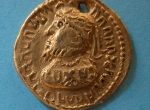 full resolution
full resolution
Fig. 1a. Obverse of the oldest published (in 1655) gold Germanic imitation from the collection of Ole Worm in Denmark, now in the National Museum in Copenhagen, © CC-BY-SA Nationalumseet, photo by Helle W. Horsnæs.
-
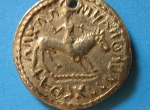 full resolution
full resolution
Fig. 1b. Reverse of the oldest published (in 1655) gold Germanic imitation from the collection of Ole Worm in Denmark, now in the National Museum in Copenhagen, © CC-BY-SA Nationalumseet, photo by Helle W. Horsnæs.
-
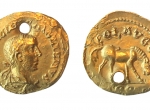 full resolution
full resolution
Fig. 2. Gold coin struck by Goths with a die stolen in AD 262 from colonial mint in Alexandria Troas in Asia Minor, private collection, photo after Gorny & H.-C. von Mosch, Giessener Münzhandlung, Auktion 126, München (14.10.2003), Nr 1818.
-
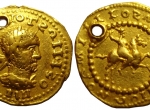 full resolution
full resolution
Fig. 3. Gold Germanic (Gothic) imitation of Ulów type found in distr. Ternopil, Ukraine, photo after O. Anochin.
-
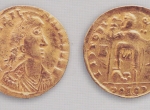 full resolution
full resolution
Fig. 4. Gold Ostrogothic(?) imitation of Valentinianus III solidus, hoard from Karsibór distr. Świnoujście, Muzeum Narodowe w Szczecinie, MNS/A/22203.


